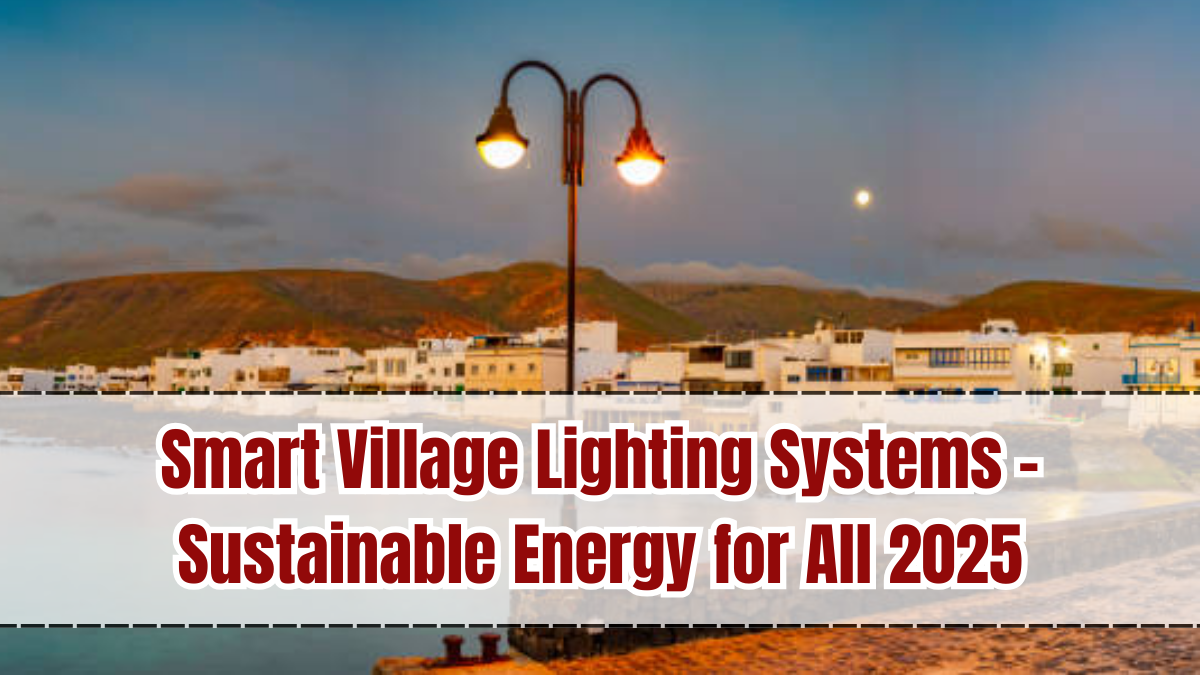Access to reliable electricity has long been a challenge in rural areas. Many villages across the world still face frequent power cuts or lack proper lighting, making it difficult for people to study, work, or even feel safe after dark. In 2025, Smart Village Lighting Systems are solving this issue with the use of solar power, IoT-enabled controls, and energy-efficient LED technology. These systems are bringing light to every corner of rural communities, improving both lifestyle and safety while promoting sustainability.

What are Smart Village Lighting Systems?
Smart Village Lighting Systems are solar-powered, sensor-based streetlights and home lighting solutions designed specifically for rural and semi-urban areas. Unlike traditional electricity-dependent lights, these systems:
-
Use solar panels to generate renewable energy.
-
Operate with LED bulbs for maximum energy efficiency.
-
Feature IoT-based sensors to control brightness and reduce wastage.
-
Store energy in long-lasting batteries for uninterrupted use at night.
-
Can be monitored and maintained through mobile and cloud platforms.
This integration of technology ensures villages have access to sustainable lighting without depending solely on traditional power grids.
Why Smart Village Lighting is Crucial in 2025
Lighting is more than just convenience; it directly impacts education, safety, and development. The importance of Smart Village Lighting Systems 2025 includes:
-
Educational Support: Students can study after sunset with proper lighting.
-
Community Safety: Well-lit streets reduce the risk of accidents and crime.
-
Economic Growth: Shops and small businesses stay open longer, boosting rural economies.
-
Gender Safety: Women feel safer walking after dark in well-lit areas.
-
Environmental Sustainability: Solar-powered lights reduce carbon emissions and dependence on fossil fuels.
By addressing these issues, smart lighting is becoming a pillar of rural development.
Benefits of Smart Village Lighting Systems
The implementation of smart lighting has multiple direct and indirect benefits:
-
24/7 Reliability: Solar storage ensures lights remain on even during power outages.
-
Lower Costs: Reduced dependency on grid electricity lowers bills for communities.
-
Eco-Friendly: Solar energy is renewable and pollution-free.
-
Smart Energy Use: IoT systems adjust brightness depending on movement, saving power.
-
Job Creation: Local technicians are trained to install and maintain systems.
-
Improved Lifestyle: Villages feel more connected and modern with proper lighting.
Role of Technology
Technology plays a critical role in making village lighting smart and efficient:
-
Solar photovoltaic panels capture energy from sunlight.
-
IoT sensors detect motion, reducing brightness when streets are empty.
-
Smart controllers balance energy storage and consumption.
-
Mobile apps allow real-time monitoring and fault reporting.
-
AI-based predictive maintenance prevents failures by identifying issues early.
This integration of renewable energy + IoT + AI ensures maximum efficiency and reliability.
Government and Private Sector Initiatives
In 2025, governments, NGOs, and private companies are investing heavily in rural electrification and smart lighting. Initiatives include:
-
Government subsidies for installing solar streetlights in rural areas.
-
CSR programs from private companies supporting village electrification.
-
Smart City and Smart Village Missions expanding into semi-urban regions.
-
International collaborations providing funding for solar-based infrastructure.
-
Training programs empowering rural youth with skills to manage smart lighting.
Countries like India are leading the way with thousands of villages adopting solar-based streetlight systems under government schemes.
Future of Smart Village Lighting
The future of Smart Village Lighting Systems looks bright in every sense. Upcoming innovations include:
-
AI-powered smart grids to balance electricity distribution.
-
Integration with EV charging stations in rural areas.
-
Hybrid systems combining solar, wind, and battery storage.
-
Remote monitoring centers ensuring zero downtime.
-
Expansion into smart home solutions, where households adopt solar-powered appliances.
By 2030, rural communities may achieve complete energy independence, powered largely by renewable technologies.
FAQs
What are Smart Village Lighting Systems?
They are solar-powered, IoT-enabled street and home lighting solutions designed to provide reliable, sustainable lighting in rural areas.
How do these systems improve rural life?
They support education, enhance safety, allow businesses to operate longer hours, and improve overall quality of life in villages.
Are Smart Village Lighting Systems affordable?
Yes, many governments and NGOs subsidize installation, making them affordable for communities and individual households.
What technology powers these lighting systems?
They use solar panels, LED bulbs, IoT motion sensors, and AI-based controllers for efficient energy use.
What is the future of Smart Village Lighting?
Future systems will integrate with AI-powered smart grids, EV charging, and hybrid renewable energy sources for complete sustainability.
Click here to know more.
